Notes
The Selling Of One Iraq
(Sorry for the extra long post. Given the significance — and hypocrisy — of the Iraqi referendum, however, I felt it was worth this broad sweep. …And no, the BAG will not be examining yesterday’s photo of the suicide bomber who blew himself up in front of the election billboard.)
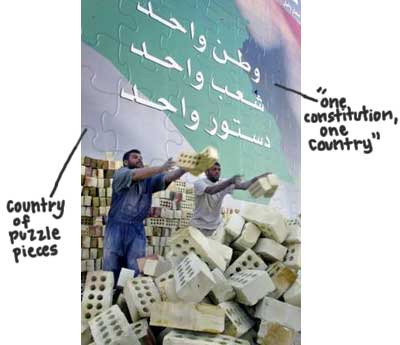
This is my fifth look at Iraqi election posters, and the third dealing with the constitution campaign. The previous entry (Held At Pen Point – link) looked at possible militaristic undertones in promoting the document; the question of whether the constitution PR appealed to, or exploited a female sensibility; and the extent to which the posters were created for (or even, by) Western interests.
The current crop of images seems a lot more professional and varied than the August examples (which were aimed at encouraging legislators to complete a draft constitution on deadline). They also seem a lot more like propaganda. In light of the constitution’s endorsement of a balkanized Iraq; the recent attempt to subvert election rules to insure the document could not be rejected; and an internal U.N. analysis– written on September 15th, and leaked to Newsweek — stating that the constitution is: a "model for the territorial division of the State," the "One Iraq" theme of this campaign could not be a bigger farce.
(I realize, by the way, there are two levels of spin to consider here. There are the posters themselves, and there is the way the posters are depicted by the photo press. Although both perspectives are interesting, I confine this post to the former, inviting you to weigh in on the latter.)
Short of a formal survey, I organized the posters into three categories: One Iraq; The Next Generation; and Iraqi Women).
One Iraq
Different posters use different strategies to visualize the
(disingenuous) notion of a unified country. There are the hands
holding up the country; the clasping hands; and the fingers with the
lapel pin.
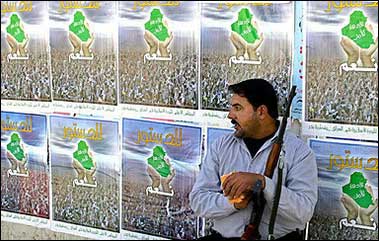
In this poster, two giant hands emerge out of a vast sea of people
to hold up the country of Iraq. Do you notice the onimous quality of
the sky? Given the three primary entities struggling for power, is it
interesting at all that two hands emerge with a hold on the country?
Could one hand be Shiite and the other Kurd?
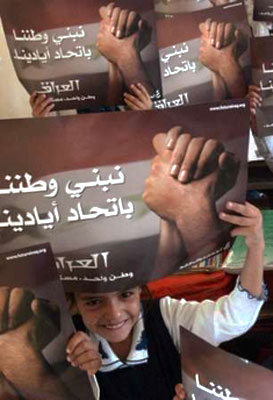
In the "interlocked hands" poster, The first two lines say "We build
(or "are building’) our country by joining our hands", and the third
line says Iraq (Al-Iraq). The last line, in very small print, says:
"One country – one future."
Strangely, this is also one of the few government
posters that evokes the Iraqi flag. Perhaps the flag has been
de-emphasized as part of the push for regional autonomy? (As you see
below, the other posters mostly steer clear of Iraq’s traditional or
customary symbols of nationalism.)
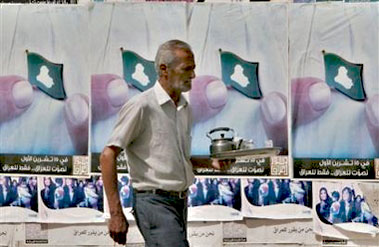
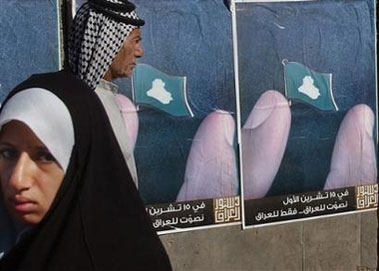
(The remainder of the commentary is provided by co-analyst Umm
Abdullah, who lives in Kuwait and has been a regular commenter on the
BAG.)
I could be wrong, but I don’t think anyone really wears lapel pins
except in the U.S., do they? I guess they think that with Iraqis
identifying themselves as members of religious sects or ethnic groups,
they want to remind them of the concept of one unified Iraq. And the
country image seems to be all white, sort of pure and unsullied by the
reality of violence and bloodshed… But the colors, as usual, are odd;
blue has no significance, and there’s no sign of the Arab colors:
green, red, white, and black.
I was asked if the first image in this series depicted a cleric
— because it might be on a robe instead of a button-down shirt. Well,
Iraqi men do wear those robes, although they don’t have any lapels!
Thinking about it further, it occurred to me that this is the
only image that would be acceptable to the strict religious Sunnis
("Salafis", "wahabbis", and others), since they don’t allow pictures of
people. (I don’t know about Shiites, but I think they must have no
problem with them, since they’re always carrying pictures of their
leaders.)
I’m curious about those fingernails – do they have nail polish
on them? Otherwise, I would have thought they were a man’s fingers. So,
is the white fabric a men’s robe, or a woman’s blouse, or what?
Actually though, it might also be a curtain.
It’s hard to read what this one says, but it’s something like: "On (some date) we will vote for Iraq – only for Iraq".
The Next Generation
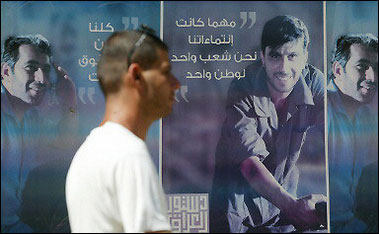
The poster with the man wearing coveralls says something like:
"Whatever we belonged to, we’re one people for one country". I’m told
that "whatever we belonged to" would be understood to mean "which sect
we belonged to" (e.g., Sunni or Shiite).
I notice that none of the men have beards, which would
otherwise indicate that they were very religious. But they’re not
clean-shaven either, which would indicate a kind of secular, maybe
pro-Western attitude. So they’ve chose the middle way here.
Iraqi Women
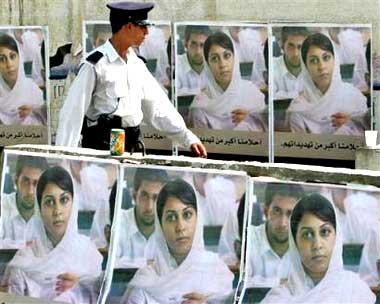
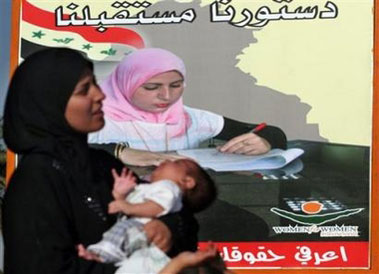
This first photo shows a woman in hijab, but it’s not really the
kind of hijab that you’d normally see in Iraq. I’m wording this
delicately, because I can’t judge someone’s piety, but this is the kind
of thing worn by some women in South Asia (Indian subcontinent,
Afghanistan, etc.), as a kind of cultural thing and not really
religious. (Think of Benazir Bhutto, who captivates reporters by
constantly letting hers slide down almost off her head and than lifting
it back up…)
If you wear a hijab for religious reasons, you don’t just drape
something over your head and let all your hair show. I’m not actually
in Iraq, so I can’t say for sure, but I doubt that you would see this
there; even if women feel like they’re forced to wear a hijab, they
probably would actually wear it the way Iraqi women wear it, and not
like this. Which makes me wonder again where these posters are made and
by whom.
This second poster has a logo for "Women for Women" (http://www.womenforwomen.org/)
which is an NGO that works with women in war-torn countries. I’ve heard
some good things about one of their women working in Iraq, Manal Omar,
who is Muslim and wears hijab (although I’m always wary of these
organizations, because usually they don’t want to accept Islamic
traditions – but this one seems better than most).
Anyway, I guess this poster is made by them, and they seem more
in touch with what Iraqi women actually look like, at least. And they
have the real Iraqi flag. The large letters say "Our constitution [is]
our future". I see a big difference between this one, and all the other
posters we’ve looked at. The woman seems like a regular person, the
colors are warm, and I think that Iraqis could relate to it.
In comparison, all of these others photos are kind of cool and distant.
(Previous Iraq election posts, in chronological order: Girls of the Constitution (a look at portrayal of women on pro-constitution posters); Held At Pen Point (examines support for constitution writing process); Poster Boy For The West (focusing on Allawi’s bid during parliamentary elections); Iraq Election Final: What’s Up A Sleeve (regarding the visual push for turnout in the parliamentary vote); and Let’s See That Glue Stick, Soldier! (looking at the desperate deployment of U.S. soldiers as electioneers).
(Thanks very much to Umm Abdullah for the observations and insight.)
Image 1: Faleh Kheiber/Reuters. October 9, 2005. Baghdad. Via
YahooNews. image 2: Qassem Zein/AFP. Date Unavailable. Najaf. Via
YahooNews. image 3: Atef Hassan/Reuters. September 28, 2005. Basra. Via
YahooNews. image 4: Karim Kadim/AP. September 28, 2005. Baghdad. Via
YahooNews. image 5: Alla Al-Marjani/AP. Najaf. October 1 2005. Via
YahooNews. image 6: Ahmad Al-Rubaye/AFP/File. Baghdad. September 18,
2005. Via YahooNews. image 7: Karim Kadim/AP. October 8, 2005. Baghdad.
Via YahooNews. image 8: Hadi Mizban/A.P. October 15, 2005. Baghdad. Via
YahooNews.)
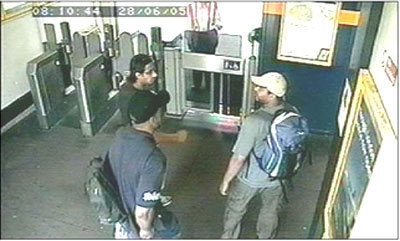
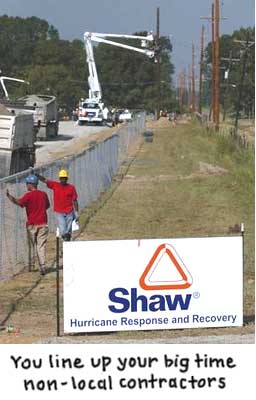
Reactions
Comments Powered by Disqus